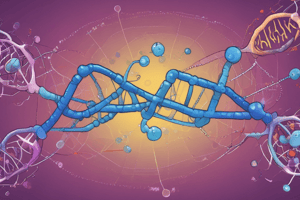Podcast
Questions and Answers
Which nucleic acid is single-stranded?
Which nucleic acid is single-stranded?
- RNA (correct)
- DNA
RNA contains the sugar ________.
RNA contains the sugar ________.
ribose
DNA contains uracil as one of its pyrimidines.
DNA contains uracil as one of its pyrimidines.
False (B)
Match the nucleic acid element with its correct nucleic acid:
Match the nucleic acid element with its correct nucleic acid:
Who isolated nuclein from the nuclei of pus cells in 1869?
Who isolated nuclein from the nuclei of pus cells in 1869?
What are the components of a nucleotide?
What are the components of a nucleotide?
RNA contains ribose sugar, while DNA contains deoxyribose sugar.
RNA contains ribose sugar, while DNA contains deoxyribose sugar.
Nucleic acids store information for cellular growth and reproduction, and are polymers consisting of long chains of monomers called _________.
Nucleic acids store information for cellular growth and reproduction, and are polymers consisting of long chains of monomers called _________.
Match the following nucleotide bases with their number of rings:
Match the following nucleotide bases with their number of rings:
Flashcards are hidden until you start studying
Study Notes
Nucleic Acids
- Nucleic acids store information for cellular growth and reproduction.
- They transfer genetic information from one generation to the next.
- There are two types of nucleic acids: Deoxyribonucleic acid (DNA) and Ribonucleic acid (RNA).
- Both DNA and RNA are polymers consisting of long chains of monomers called nucleotides.
Nucleotides
- Nucleotides contain three components: a nitrogenous base, a pentose sugar, and a phosphate group.
- Nitrogenous bases are non-protein, cyclic compounds having nitrogen.
- There are two types of nitrogenous bases: Purines (with two rings) and Pyrimidines (with one ring).
- Pentose sugars are ribose (in RNA) and deoxyribose (in DNA).
- The sugar and phosphate group form the backbone of nucleic acids, while the nitrogenous bases project inward from the backbone.
Nucleosides and Nucleotides
- A nucleoside consists of a nitrogenous base linked by a glycosidic bond to C1’ of a ribose or deoxyribose.
- A nucleotide is a nucleoside that forms a phosphate ester with the C5’ OH group of ribose or deoxyribose.
Functions of Nucleotides
- Nucleotides are energy carriers, electron carriers, coenzymes, and activators of metabolites.
- They are also involved in the expression and transmission of genetic information.
Nucleotide as Energy Carrier
- Nucleotides carry chemical energy in cells in the form of nucleoside mono-, di-, and triphosphates.
- Hydrolysis of nucleoside triphosphates provides the chemical energy to drive a wide variety of cellular reactions.
Central Dogma
- The central dogma is the process by which genetic information is transferred from DNA to RNA to proteins.
DNA and RNA Structure
- DNA is a double-stranded helix with two strands of nucleotides that wind together in opposite directions.
- The base pairs are arranged in step-like pairs and held together by hydrogen bonding.
- RNA is single-stranded and transmits information from DNA to make proteins.
Types of RNA
- There are three major classes of RNA: messenger RNA (mRNA), transfer RNA (tRNA), and ribosomal RNA (rRNA).
- mRNA carries genetic information from DNA to the ribosomes.
- tRNA brings amino acids to the ribosome to make proteins.
- rRNA makes up 2/3 of ribosomes where protein synthesis takes place.
Genetic Code
- The genetic code is a collection of base sequences that corresponds to each amino acid.
- It is a triplet of nucleotides that code for 20 amino acids.
mRNA
- mRNA has a long sequence of adenine nucleotides (a “poly-A tail”) on the 3’-end of the RNA chain.
- It also has a “cap” on the 5’-end consisting of a molecule of 7-methylguanosine.
tRNA
- tRNA has a triplet called an anticodon that complements a codon on mRNA.
- It bonds to a specific amino acid at the acceptor stem.
rRNA
- rRNA is found in association with several proteins as components of the ribosomes.
- There are three distinct sizes of rRNA: 23S, 16S, and 5S in prokaryotes, and 28S, 18S, 5.8S, and 5S in eukaryotes.
Differences between DNA and RNA
- DNA is double-stranded, while RNA is single-stranded.
- DNA has deoxyribose sugar, while RNA has ribose sugar.
- DNA has thymine as a pyrimidine base, while RNA has uracil.
- DNA is found in the nucleus and mitochondria, while RNA is found in the nucleus, mitochondria, and cytoplasm.
Studying That Suits You
Use AI to generate personalized quizzes and flashcards to suit your learning preferences.




